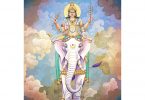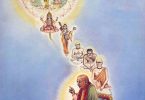Q. In BG As It Is chapter 3, Srila Prabhupada clarifies that the performance of sacrifices for Krishna (Vishnu) are required for spiritual elevation and for comfortable living in the material world. He goes on in verses 3.10, 3.12, 3.13 (and perhaps others) to elaborate that sacrifices are very difficult to perform in this age, but that the merciful Chaitanya Mahaprabhu has made the sankirtan sacrifice more available for this purpose.
The question I’d like to humbly place before your superior knowledge is: although we do perform sankirtan in ISKCON temples, it doesn’t seem that the sankirtan process is greatly emphasized at this time. Can you please give insight into whether I am overlooking the emphasis it is being given, or why at this particular time it is not so highly emphasized if it is described as one of the few types of sacrifices we are qualified to perform in this age?
Answer by Romapada Swami: Sankirtana is undoubtedly the easiest, most appropriate and recommended method of sacrifice for this age. Srila Prabhupada called it the Universal religion — unlike other methods of sacrifices, all classes of people can equally take part in sankirtana – irrespective of language, religious denomination, education, social status or any other consideration.
Certainly Srila Prabhupada emphasized it greatly, throughout his writings, as well as in his practical directions to his disciples. In fact, it was because of the massive sankirtan parties organized under his direction – with his disciples going out en masse into the streets of every major city and enthusiastically chanting Hare Krishna in rain or shine — that Hare Krishna became a popular household word around the world.
It is not clear whether your question refers to the emphasis on sankirtan within our movement, or in general among other followers of Vedic traditions. At least in India, among those who are religiously minded, it is common knowledge that hari-nama-sankirtana is the most effective process for this age, although due to lack of systematic education, it is not always performed in the authorized way and many continue to be devoted to other forms of traditional and ritualistic practices.
In any case, the importance of sankirtana yajna cannot be overemphasized, and it is always nice to seek opportunities and find ways and means to increase sankirtana performances both within devotee communities and also impress upon others of its importance.
Japa and Book Distribution as Sankirtana:
Although sankirtana particularly refers to ‘congregational chanting’ of the Holy Names, it also includes our regular, individual chanting of japa. Due to consideration of time, place and lifestyle, even if it is not possible for people to daily come together to chant congregationally, the practice of daily chanting prescribed number of rounds of the Hare Krishna mahamantra is very much stressed.
The publishing and distribution of devotional literatures in glorification of Krishna is also Sankirtana. Srila Bhaktisiddhanta Sarasvati Thakur as well as our Srila Prabhupada referred to it as “brihat-mridanga” — glorification of Krishna that can be heard by millions of people.
Performing Duties and other services as part of Sankirtana Yajna:
For a variety of reasons, our movement in North America (which is primarily your frame of reference, or personal experience) has largely become congregation based. Unless one is sufficiently purified, it is not possible for the conditioned soul to renounce other prescribed duties and constantly chant Hare Krishna, or render the full scale of activities found within the ashramas of renunciates. Therefore, the yajna of rendering one’s occupation as an offering or sacrifice to Visnu depends upon the accompaniment of chanting the holy name. This yajna of the Holy Name is japa-yajna, minimally.
Artificial attempts to increase chanting cannot be sustained over time without proper engagements to purify the mind and senses, and without responsibly discharging one’s prescribed occupational duties. Thus, along with cultivating regulated practices of chanting and hearing, one should simultaneously perform one’s occupational duties in a ‘spirit of sacrifice to the Supreme.’ How to perform one’s duties in this way is an important message of Chapter 3 of Bhagavad-gita. There must also be a balanced program of hearing of Krishna-katha, study of scriptures, and practical engagements to cultivate humility and service attitude — all these are meant to support and enhance our absorption in chanting and sankirtana. They are all inter-related, and are not to be seen as disjointed activities independent of chanting. Our primary process of purification in this age is chanting, and when all other activities are seen as a support to spiritual awakening, then that is also sankirtana.
A devotee may be working as an artist or scientist or administrator, but if the purpose of all those engagements is purely for the glorification of Krishna, then that is also sankirtana. (Please see SB 1.5.22 p) Srila Prabhupada very much wanted the devotees to cultivate this spirit of sacrifice in all their activities and thus he writes “… the very life of the devotee is a symbol of sacrifice.” (SB 1.16.20)
All this is not to minimize the importance of direct congregational chanting of the Holy Names and glories of the Lord. This is the most important and sublime process of self-realization for this age — all other activities are to be seen as integral parts of this sankirtana process, as a support to increase our absorption in chanting, but not in lieu of direct participation in sankirtana.







